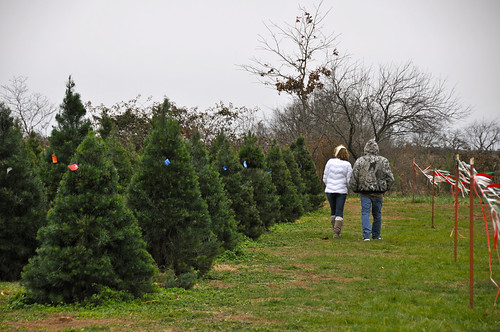Freshness, needle drop factor into Christmas tree selection
Dec. 5, 2018
By Mary Hightower
U of A System Division of Agriculture
Fast facts:
- Arkansas tree farms likely to have Leyland cypress, Virginia Pine
- Americans bought 27.4 million real trees in 2017, same as 2016
(551 words)
(With file art at https://flic.kr/p/NPkdFX )
LITTLE ROCK – Americans selecting Christmas trees for the season’s biggest holiday aren’t only looking at shape and size, according to experts at the University of Arkansas System Division of Agriculture. Longevity counts, too.
“In terms of what lasts the longest, the freshest ones last the longest,” said Tamara Walkingstick, associate director of the Arkansas Forest Resources Center and an extension forester for the Division of Agriculture. “That's why choosing and cutting a live tree can be so rewarding.

“Some of the species like the Leyland cypress don't readily lose their needles, so that's a plus,” she said. “Some like the Eastern Red Cedar have needles that you find in your carpet in June.”
Walkingstick said that most pre-cut trees have been sprayed with a desiccant to retain freshness.
For many, selecting their own tree is a family holiday tradition. There are many Christmas tree farms that cater to “this experience complete with wagon rides, hot chocolate and the whole works,” she said.
Walkingstick said that in Arkansas, tree farms grow mostly Virginia pine, Leyland Cypress, Arizona Cypress, Eastern Red Cedar, and a little Scotch pine in the northwestern corner of the state.
“The other more popular species, such as Fraser fir, don’t grow here,” she said. “We do not have the right soil or growing conditions.”
However, pre-cut Fraser firs are very popular at tree lots and Christmas tree farms that sell pre-cut trees along with choose-and-cut.
“Fraser fir is perhaps the most popular tree in the country and most of what we buy here comes from North Carolina where it is a huge crop,” Walkingstick said. “Some of the other species imported for resale here are noble fir, blue spruce and some white pine.”
According to the National Christmas Tree Growers Association, about a quarter of the Christmas sold in 2017 came from pick-your-own farms and another quarter came from the big lot stores like Lowe's and Walmart.
The most recent information from the U.S. Department of Agriculture shows that in Arkansas, nearly 9,000 trees were harvested and sold as Christmas trees in 2014. The National Christmas Tree Association in its 2017 consumer snapshot, found that:
- 27.4 million real Christmas trees were purchased in 2017, same as in 2016. On average the survey participants reported they paid $75 for a real tree in 2017.
- 21.1 million new fake trees were purchased in 2017; on average the survey participants reported they paid $107 for a new artificial tree in 2017.
Keep it fresh
To lengthen the life of your tree, “Check the water level and sometimes mist it with water,” Walkingstick said. “However, after a few weeks, it's going to get dry. When it’s ready to come down, recycle it in your yard or pond, but never, ever burn it in your fire place.”
No-cut zones
While some commercials romanticize the idea of heading to the woods with the family to cut a tree down, tie it to their car roof, and drive home, “unless it is their own land, this is really not feasible,” she said. “People cannot cut trees on state or federal land and should not cut on private land without express consent from the owners.”
For more information on trees and forestry, contact your county extension office or visit www.uaex.uada.edu.
About the Division of Agriculture
The University of Arkansas System Division of Agriculture’s mission is to strengthen agriculture, communities, and families by connecting trusted research to the adoption of best practices. Through the Agricultural Experiment Station and the Cooperative Extension Service, the Division of Agriculture conducts research and extension work within the nation’s historic land grant education system.
The Division of Agriculture is one of 20 entities within the University of Arkansas System. It has offices in all 75 counties in Arkansas and faculty on five system campuses.
Pursuant to 7 CFR § 15.3, the University of Arkansas System Division of Agriculture offers all its Extension and Research programs and services (including employment) without regard to race, color, sex, national origin, religion, age, disability, marital or veteran status, genetic information, sexual preference, pregnancy or any other legally protected status, and is an equal opportunity institution.
# # #
Media Contact: Mary Hightower
Dir. of Communication Services
U of A System Division of Agriculture
Cooperative Extension Service
(501) 671-2126
mhightower@uada.edu